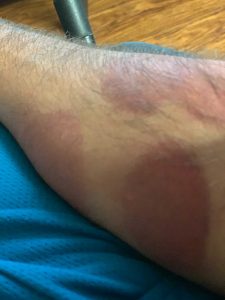Alternative Treatments for Friedreich’s Ataxia: Cupping and Me

It wasn’t a comfortable feeling.
With every press of my physical therapist’s tiny handheld pump, the edges of a small plastic cup seemed to pinch my skin a little more tightly.
I had several suction cups placed on my arms, hips, and legs.
“Some people say cupping hurts worse than needles,” my physical therapist told me, referring to dry needling.
They’re not wrong, I thought.
***
I previously wrote that I believe dry needling is beneficial for me as a Friedreich’s ataxia (FA) patient. Dry cupping, the activity we were currently doing, is another alternative therapy technique.
Cupping is an ancient technique, popular when bleeding people (sometimes using leeches) was a standard practice. A common focus in the medical field was removing elements of sickness from the body: Leeches removed tainted blood, and cupping was thought to remove harmful spirits.
Cupping mostly went away as healthcare evolved, but the practice has seen a surprising resurgence in the last decade thanks to the testimonies of famous athletes, such as Michael Phelps.
Instead of ridding the body of toxic spirits, dry cupping is now believed to improve blood circulation.
Read more about cupping here.
***
At my appointment, I asked my physical therapist for the umpteenth time through clenched teeth, “So, we’re using cupping to try to increase the blood flow in areas that may be restricted because of my ataxia?” I knew the answer was yes; I just wanted validation for undergoing this uncomfortable, unorthodox treatment. Without waiting for an answer, I asked, “Do you think it helps FA?”
“I couldn’t tell ya,” my physical therapist, with the patience of a mountain and the honesty of a saint, told me. “All I know is I’ve seen it help many of my other clients. I don’t know about the best therapies for FA, so I’m acting like a mad scientist here.”
I like that analogy, I thought, as he pumped air out of another plastic cup, its sides digging into the skin on my hip.
***
The truth is I love being as physically active as I can. From riding recumbent trikes to using my standing frame to attending weekly physical therapy appointments, I am slowly transitioning from helplessly watching Friedreich’s ataxia ravage my capabilities to actively fighting for the slightest hint of slowing progression, for any glimmer of maintaining my current state of functioning.
Because there is currently no treatment or cure for Friedreich’s ataxia, I am open to most alternative methods of trying to limit FA’s progression.
I am too impatient to simply wait around for a salve that may or may not come.
So, I am something of a mad scientist myself.
After the dry cupping session was over, I purposefully fell onto the floor and practiced some exercises there, such as getting up on my hands and knees and getting into the “Cobra” yoga position. My physical therapist has told me to try lying on my back while attempting to kick my legs onto an exercise ball near my feet. Normally, the moves are very jaunty and uncontrolled; I am lucky if my legs flail upward in a kick like jerky lightning bolts near the top of the ball. This normally makes me discouraged.
Unexpectedly, my legs didn’t flail very much this time. Even though this activity was still frustratingly difficult, I was able to slowly put one foot on top of the ball, and then the other.
“Wow,” said my physical therapist, “so much more control.”
My movements were still erratic, and nowhere near graceful or easy.
I don’t know if the improvement is a result of cupping, needling, birthday wishes, karma, or the placebo effect.
“So much more control” isn’t quite the eureka moment I wish for. It’s not the same as a mad scientist shouting, “It’s alive!”
But for the moment, it’s close enough.
***
Friedreich’s Ataxia News is strictly a news and information website about the disease. It does not provide medical advice, diagnosis or treatment. This content is not intended to be a substitute for professional medical advice, diagnosis, or treatment. Always seek the advice of your physician or another qualified health provider with any questions you may have regarding a medical condition. Never disregard professional medical advice or delay in seeking it because of something you have read on this website.The opinions expressed in this column are not those of Friedreich’s Ataxia News or its parent company, Bionews, and are intended to spark discussion about issues pertaining to Friedreich’s ataxia.








Leave a comment
Fill in the required fields to post. Your email address will not be published.